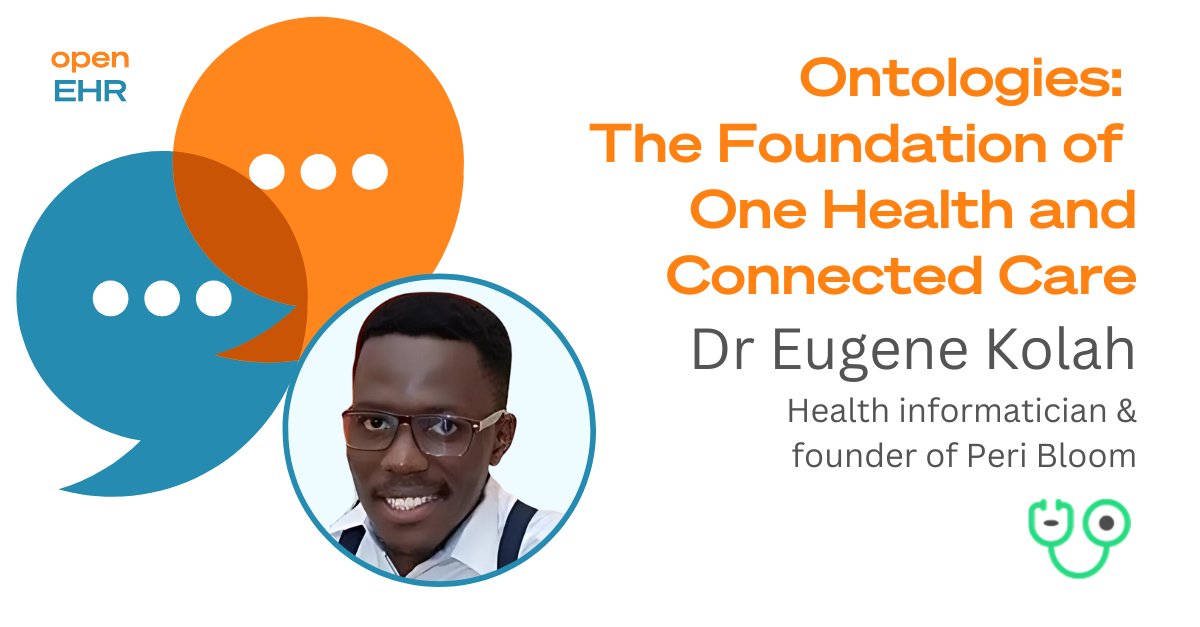I’m Dr Eugene Kolah, founder and CEO of Peri Bloom, a health IT organisation that operationalises interoperability through data standardisation and patient-centered technology.
Ontologies: The Foundation of One Health and Connected Care with BloomCloud™
At the organisation I work for, diving deep into what truly connects us – humans, animals, and the environment – is a culture that powers innovation for health. What better place to start than the foundations: ontologies? BloomCloud™, our openEHR-based clinical data repository (CDR), leverages a persistent layer for holding ontologies, ensuring the data that drives health initiatives is both structured and connected. If ontologies at any point felt like a term best left to academics, don’t worry. I’m here to break it down and show you how this all ties into health IT work and beyond.
What are ontologies?
Ontologies have a rich history rooted in philosophy, where they began as a way to categorise and understand the nature of existence and relationships. In modern times, they have evolved into powerful tools for structuring knowledge in domains like healthcare, life sciences, and technology. Their richness lies in their ability to define key concepts and the intricate relationships between them, such as how diseases can affect both humans and animals or how vaccination prevents illness. This structured framework ensures consistency and clarity across disciplines.
At their core, ontologies are about organising and connecting data in a way that makes sense to both humans and machines. That’s why they’re often called the backbone of semantic technology; they allow systems to communicate in a standardised way, even if they were built by different organisations or in different countries.
Why are ontologies important?
One of the key challenges facing the healthcare sector today is the fragmentation of data, which flows in from countless sources: hospitals, labs, pharmacies, GP surgeries, and more. This fragmentation creates challenges like miscommunication between systems, data silos, and inconsistencies in how information is understood or used. Ontologies address this by bringing structure and clarity, ensuring that critical terms are universally defined and interpreted the same way by different operators. This foundational work is crucial for:
- Interoperability: systems’ ability to talk to each other without misunderstandings.
- Data analysis: insights that can be drawn because data is structured and connected.
- Innovation: standardised data allows for the creation of powerful tools and technologies.
The One Health Connection
You’ve probably heard about “One Health,” but let’s revisit it. One Health is an approach that recognises the interconnection between the health of humans, animals, and the environment. COVID-19, zoonotic diseases, antimicrobial resistance; these are just a few examples that highlight why we can’t afford to think about human health in isolation.
Ontologies are central to making One Health work, because they enable us to connect data across disciplines:
Human Health Ontologies (like SNOMED CT or ICD): these are essential for organising concepts such as diseases, symptoms, treatments, and care pathways. Use case examples include improving electronic health record (EHR) systems, enabling seamless communication between hospitals, and supporting clinical decision-making tools.
Animal Health Ontologies (like the Animal Disease Ontology and VICO): these help structure data in veterinary medicine, track zoonotic diseases, and manage vaccination programs for livestock and pets. In doing so, they allow for real-time monitoring of outbreaks like avian influenza or rabies.
Environmental Ontologies (like ENVO and SWEET): these focus on relationships between ecosystems, climate factors, and disease spread, with cases that include modelling the impact of climate change on vector-borne diseases or mapping pollution sources contributing to respiratory illnesses.
Genomic Ontologies (like Gene Ontology): these are crucial for linking genetic data to disease; aiding in personalised medicine while supporting research on antimicrobial resistance.
By working together in a collaborative way to integrate these ontologies, systems can tackle complex problems across disciplines, such as predicting the spread of zoonotic diseases or coordinating responses to global health crises.
Ontologies create a shared language that lets us integrate data from a hospital in Nairobi, a veterinary clinic in Sydney, and a climate monitoring station in the Arctic. That’s the power of standardisation.
How Peri Bloom fits in
The organisation I’ve been working for (for more than 7 years now) has always been about using mature data standards to create impactful solutions. The BloomCloud™ platform is a great example of this in action. While our focus remains human health, it can also be adapted to other domains related to human health for research purposes. Showcasing how technology built on ontologies opens broad research and collaborative opportunities within the ecosystem. It serves as a persistent layer for advancing One Health, fostering research and innovation across interconnected domains.
So, why should you care?
In short, ontologies can help us to make better decisions. For clinicians, they mean better tools. For policymakers, they mean better data. And all this boils down to a healthier world, for all of us.
If you’ve ever wondered how technology can bridge the gaps between different sectors and systems, ontologies are the answer. They’re not just for geeks; they’re for anyone who cares about creating connected, informed solutions.
I’ll be diving into the One Health space, and I’m excited to share more about how using ontologies can make it happen. Stay tuned for updates on our projects and more deep dives into how these concepts apply to the real-world. After all, the foundations are always the best place to begin.

Leave a Reply